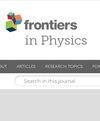基于简单等离子体-介质-等离子体(PDP)波导的 U 型光谱形成机制
IF 1.9
3区 物理与天体物理
Q2 PHYSICS, MULTIDISCIPLINARY
引用次数: 0
摘要
利用等离子体-介质-等离子体(PDP)波导或等离子体阵列结构操纵电磁波(EM),在微波信号处理(如滤波、信号延迟、电磁增强或屏蔽)方面具有巨大潜力。由于结构简单、易于制造,带有齿形谐振器的波导一直是滤波设备的理想选择。基于我们之前对双齿结构 PDP 波导所激发的 U 型滤波的研究,本研究利用适当场分布的传输线理论(TLT)系统地探讨了 U 型滤波频谱的形成机制。结果表明,U 型频谱由边界边缘和滤波阻带组成。边界边缘归因于法诺型共振,而双齿增强的破坏性干扰则是阻带的原因。这种方法显示了产生 U 型频谱的具体而清晰的机制。此外,还利用 TLT 对无 Fano 型共振的双齿进行了严格的理论分析,这在理论上大大有助于止带滤波的带宽调制。这些结果有助于理解带有齿形谐振器的间隙等离子体波导(如 PDP 或金属-绝缘体-金属 (MIM))U 形频谱的形成机制,为优化滤波特性提供了可行的方向,并为后续实验设计提供了重要参数。本文章由计算机程序翻译,如有差异,请以英文原文为准。
Formation mechanism of the U-shaped spectrum based on a simple plasma–dielectric–plasma (PDP) waveguide
Manipulating electromagnetic (EM) waves by plasma–dielectric–plasma (PDP) waveguides or plasma array structures presents significant potential in microwave signal processing, such as filtering, signal delay, and EM enhancement or shielding. Owing to the simple structure and easy fabrication, the waveguide with a tooth-shaped resonator has been a strong candidate as a filtering device. Based on our previous work focusing on U-shaped filtering excited by PDP waveguides with a double-teeth structure, in this work, the formation mechanism of a U-shape filtering spectrum is systematically explored by transmission line theory (TLT) with proper field distributions. The results indicate that the U-shape spectrum consists of boundary edges and a filtering stopband. The boundary edges are attributed to Fano-type resonance, and the enhanced destructive interference from double teeth is responsible for the stopband. Such an approach shows a specific and clear mechanism for the generated U-shaped spectrum. In addition, the theoretical analysis of double teeth without Fano-type resonances is rigorously demonstrated using TLT, which significantly contributes to bandwidth modulation of stopband filtering in theory. These results contribute to the understanding of the formation mechanism of a U-shaped spectrum from a gap plasmon waveguide (such as PDP or metal–insulator–metal (MIM)) with tooth-shaped resonators, offering a feasible direction for the optimization of filtering properties, as well as offering significant parameters for subsequent experimental design.
求助全文
通过发布文献求助,成功后即可免费获取论文全文。
去求助
来源期刊

Frontiers in Physics
Mathematics-Mathematical Physics
CiteScore
4.50
自引率
6.50%
发文量
1215
审稿时长
12 weeks
期刊介绍:
Frontiers in Physics publishes rigorously peer-reviewed research across the entire field, from experimental, to computational and theoretical physics. This multidisciplinary open-access journal is at the forefront of disseminating and communicating scientific knowledge and impactful discoveries to researchers, academics, engineers and the public worldwide.
 求助内容:
求助内容: 应助结果提醒方式:
应助结果提醒方式:


